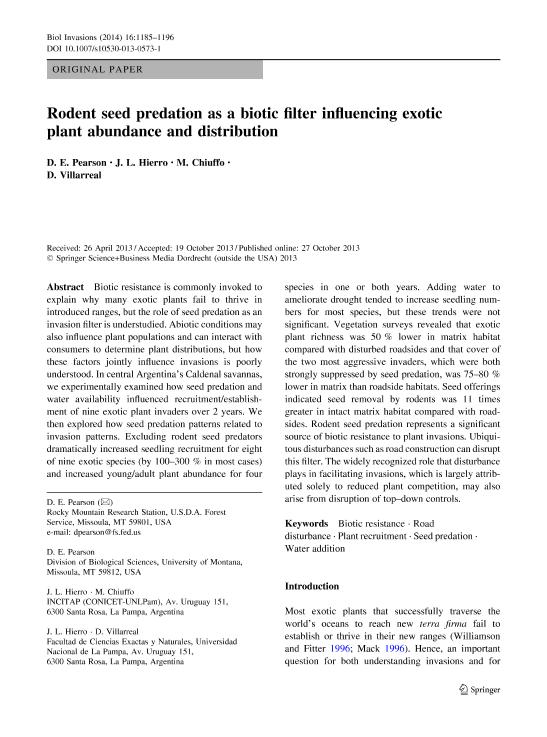Mostrar el registro sencillo del ítem
dc.contributor.author
Pearson, D.E.
dc.contributor.author
Hierro, Jose Luis

dc.contributor.author
Chiuffo, Mariana Cecilia

dc.contributor.author
Villarreal, D.
dc.date.available
2017-06-29T15:51:57Z
dc.date.issued
2014-05
dc.identifier.citation
Pearson, D.E.; Hierro, Jose Luis; Chiuffo, Mariana Cecilia; Villarreal, D.; Rodent seed predation as a biotic filter influencing exotic plant abundance and distribution; Springer; Biological Invasions; 16; 5; 5-2014; 1185-1196
dc.identifier.issn
1387-3547
dc.identifier.uri
http://hdl.handle.net/11336/19125
dc.description.abstract
Biotic resistance is commonly invoked to explain why many exotic plants fail to thrive in introduced ranges, but the role of seed predation as an invasion filter is understudied. Abiotic conditions may also influence plant populations and can interact with consumers to determine plant distributions, but how these factors jointly influence invasions is poorly understood. In central Argentina’s Caldenal savannas, we experimentally examined how seed predation and water availability influenced recruitment/establishment of nine exotic plant invaders over 2 years. We then explored how seed predation patterns related to invasion patterns. Excluding rodent seed predators dramatically increased seedling recruitment for eight of nine exotic species (by 100–300 % in most cases) and increased young/adult plant abundance for four species in one or both years. Adding water to ameliorate drought tended to increase seedling numbers for most species, but these trends were not significant. Vegetation surveys revealed that exotic plant richness was 50 % lower in matrix habitat compared with disturbed roadsides and that cover of the two most aggressive invaders, which were both strongly suppressed by seed predation, was 75–80 % lower in matrix than roadside habitats. Seed offerings indicated seed removal by rodents was 11 times greater in intact matrix habitat compared with roadsides. Rodent seed predation represents a significant source of biotic resistance to plant invasions. Ubiquitous disturbances such as road construction can disrupt this filter. The widely recognized role that disturbance plays in facilitating invasions, which is largely attributed solely to reduced plant competition, may also arise from disruption of top–down controls.
dc.format
application/pdf
dc.language.iso
eng
dc.publisher
Springer

dc.rights
info:eu-repo/semantics/openAccess
dc.rights.uri
https://creativecommons.org/licenses/by-nc-sa/2.5/ar/
dc.subject
Biotic Resistance
dc.subject
Road Disturbance
dc.subject
Plant Recruitment
dc.subject
Seed Predation
dc.subject
Water Adi
dc.subject.classification
Ecología

dc.subject.classification
Ciencias Biológicas

dc.subject.classification
CIENCIAS NATURALES Y EXACTAS

dc.title
Rodent seed predation as a biotic filter influencing exotic plant abundance and distribution
dc.type
info:eu-repo/semantics/article
dc.type
info:ar-repo/semantics/artículo
dc.type
info:eu-repo/semantics/publishedVersion
dc.date.updated
2017-06-29T13:58:36Z
dc.identifier.eissn
1573-1464
dc.journal.volume
16
dc.journal.number
5
dc.journal.pagination
1185-1196
dc.journal.pais
Suiza

dc.description.fil
Fil: Pearson, D.E.. University of Montana; Estados Unidos. United States Department of Agriculture; Estados Unidos
dc.description.fil
Fil: Hierro, Jose Luis. Consejo Nacional de Investigaciones Científicas y Técnicas. Instituto de Ciencias de la Tierra y Ambientales de La Pampa. Universidad Nacional de La Pampa. Facultad de Ciencias Exactas y Naturales. Instituto de Ciencias de la Tierra y Ambientales de La Pampa; Argentina. Universidad Nacional de La Pampa. Facultad de Ciencias Exactas y Naturales; Argentina
dc.description.fil
Fil: Chiuffo, Mariana Cecilia. Consejo Nacional de Investigaciones Científicas y Técnicas. Instituto de Ciencias de la Tierra y Ambientales de La Pampa. Universidad Nacional de La Pampa. Facultad de Ciencias Exactas y Naturales. Instituto de Ciencias de la Tierra y Ambientales de La Pampa; Argentina
dc.description.fil
Fil: Villarreal, D.. Universidad Nacional de La Pampa. Facultad de Ciencias Exactas y Naturales; Argentina
dc.journal.title
Biological Invasions

dc.relation.alternativeid
info:eu-repo/semantics/altIdentifier/url/http://link.springer.com/article/10.1007/s10530-013-0573-1
dc.relation.alternativeid
info:eu-repo/semantics/altIdentifier/doi/http://dx.doi.org/10.1007/s10530-013-0573-1
Archivos asociados
